A review of convergence funding for agriculture in Scotland
Scotland has the lowest amount of direct farm funding per hectare of farmland in the European Union. There is a some feeling in Scotland that this is unfair, due to decisions made by the UK Government in 2013. This short briefing considers the background to the Intra UK-Funding Allocations Review chaired by Lord Bew, ahead of the publication of the review report later in the summer.
Executive Summary
In 2018 the Common Agricultural Policy (CAP) provided €58.83 billion of support to EU farmers. The CAP provides a framework for agricultural policy across the European Union.
The CAP consists of two pillars. Under Pillar 1 farmers are given support for working farmland, subject to certain conditions. Under Pillar 2 farmers and other rural businesses can apply for funds to carry out particular activities.
During negotiation of the 2014-2020 CAP programme at EU level, a convergence mechanism was agreed. This meant that Member States with low payment rates per hectare, received additional money. Because of the very low payment rate in Scotland, the UK was allocated an additional €223 million - around £190 million.
In 2013, when allocating CAP funds across UK countries, the UK government decided that the historic intra-UK split would remain. This meant that the additional funding received by the UK because of Scotland's poor per hectare payment rate, would be split between the UK countries.
For 2020 Scotland has the lowest amount of direct farm funding, per hectare of farmland, in the EU. However, when considered by claimant, rather than per hectare, Scotland has one of the highest rates of direct farm funding, per farm, in the EU.
The Scottish Government has said that Scottish hill farmers are owed £160 million in CAP funding from the UK Government. However, the majority of Pillar 1 funding in Scotland does not currently go to hill farmers, but to farmers with better quality agricultural land, used for arable cropping, temporary grass and permanent grass.
The allocation of CAP funding in the UK has remained controversial since 2013. The UK Government has initiated an independent review (the Bew review) into the factors that should be considered to make sure that funding for domestic farm support is fairly allocated.
The report of the review is due out soon.
The Common Agricultural Policy
According to the European Commission, the EU’s common agricultural policy (CAP) is a partnership between agriculture and society, and between Europe and its farmers. The CAP is managed and funded at European level from the EU’s budget. The CAP aims to -
support farmers and improve agricultural productivity, ensuring a stable supply of affordable food;
safeguard European Union farmers to make a reasonable living;
help tackle climate change and the sustainable management of natural resources;
maintain rural areas and landscapes across the EU;
keep the rural economy alive by promoting jobs in farming, agri-food industries and associated sectors.
In 2018 the CAP provided €58.82 billion of support to EU farmers1.
The Common Agricultural Policy in Scotland
The CAP comprises two pillars, each made up of a number of schemes. How CAP is implemented in Scotland is a devolved matter.
Pillar 1
Under Pillar 1, farmers are given support for working farmland, subject to certain conditions. These are known as direct payments or basic payments. The Basic Payment Scheme acts as a safety net for farmers and crofters by supplementing their main business income.
Greening payments are a mandatory component of Pillar 1. Greening was introduced with the aim of improving the environmental performance of farming. A greening payment 'for agricultural practices beneficial for the climate and environment' is paid on top of the basic payment to farmers. They make up 30% of the Pillar 1 budget.
Pillar 1 in Scotland also includes the Scottish Suckler Beef Support Scheme and the Scottish Upland Sheep Scheme. These schemes are unique in the UK to Scotland and couple (or link) payment to livestock production1.
More on direct payments can be found in the June 2019 SPICe Spotlight blog Agricultural policy post-Brexit – risky business?
Pillar 2
Under Pillar 2, farmers and other rural businesses can apply for funds to carry out particular activities, often related to the environment, climate change, woodlands or wider rural development. Pillar 2 in Scotland is known as the Scottish Rural Development Programme.
The figure below shows the different schemes within CAP in Scotland.
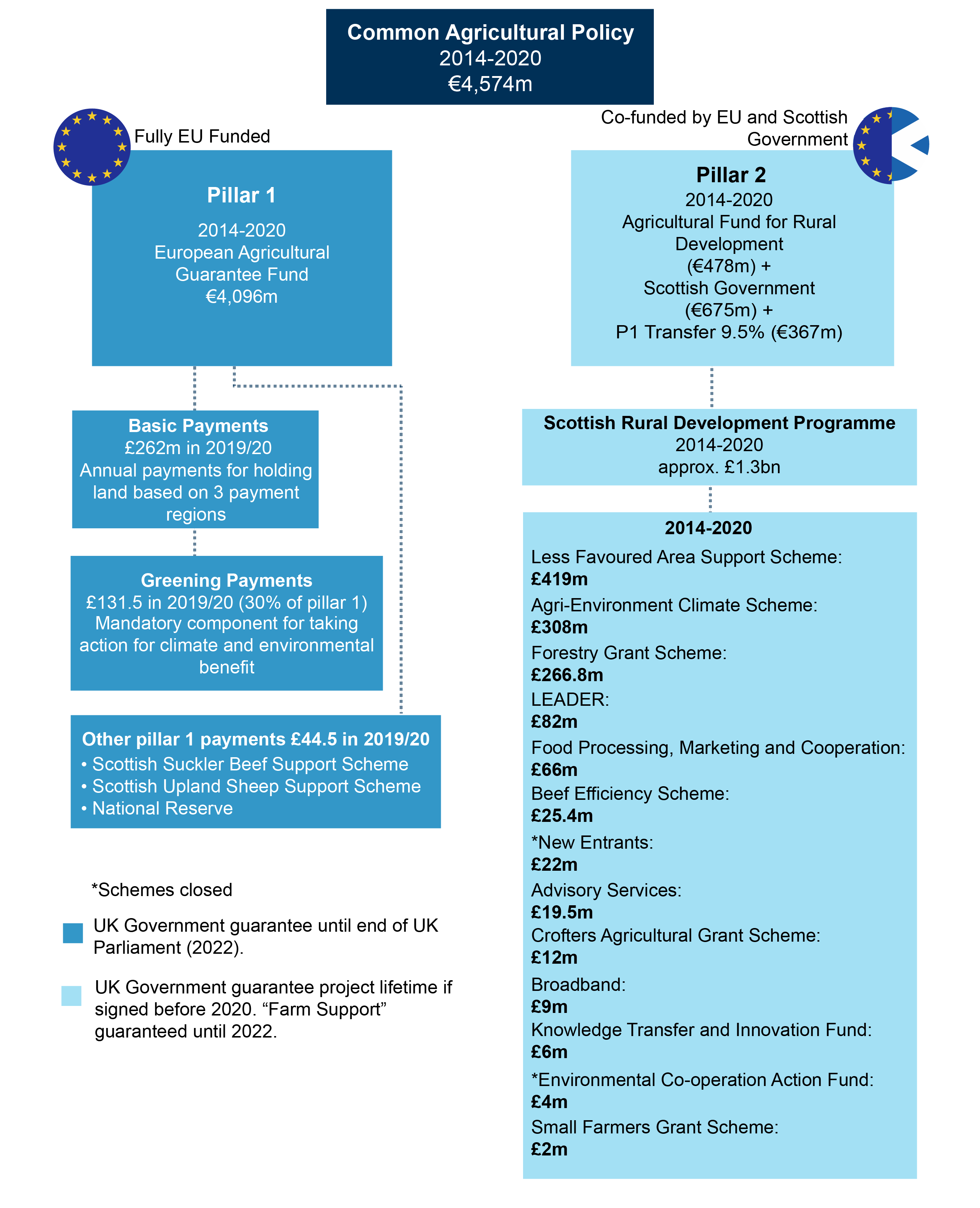
The Convergence Mechanism
During negotiation of the 2014-2020 CAP programme at EU level, a convergence mechanism was agreed. This aimed to bring the amount of Pillar 1 funding all Member States received closer to the EU average, based on a per-hectare payment measure. The average EU payment rate was €268 per ha1. So, Member States with low payment rates per hectare, received additional money.
As the graph below shows, Scotland had a very low per hectare payment rate at the time.

Wales and England received around the EU average payment
Northern Ireland was higher than the EU average, and
Scotland received amongst the lowest payment per hectare of €130 per hectare.2
Because of the very low Scottish rate, the UK was allocated an additional €223 million through this convergence mechanism - around £190 million - over the period 2014-2020.
Allocation of the CAP funding 2014-2020
The UK Government announced the allocation of CAP funds to UK countries on 8 November 2013. It said -
The Common Agricultural Policy allocations for England, Northern Ireland, Scotland and Wales will remain the same for the next funding period.
This meant that the historic intra-UK split of direct payments remained - the additional convergence funding received by the UK because of Scotland's poor per hectare payment rate, would be split between the UK countries. The following Pillar 1 allocation was announced -
England = €16,421 million
Scotland = €4,096 million
Northern Ireland = €2,299 million
Wales = €2,245 million.
Scotland was allocated €4,096 million of Pillar 1 funds and €478 million of Pillar 2 funds for the CAP programme 2014-20201. That represents around 17% of the total UK CAP budget.
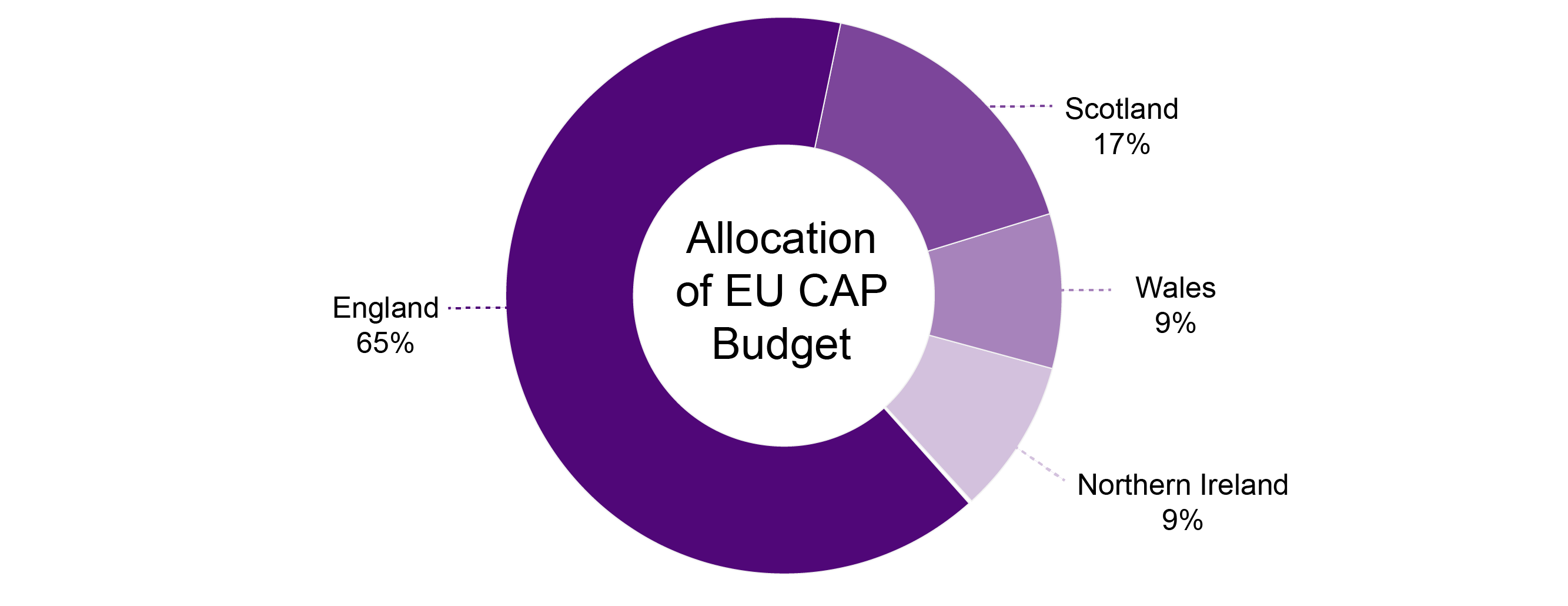
The Scottish Government argues that £160 million over the period 2014-2020 is due to Scotland -
The UK only qualified for a £190 million uplift because Scotland’s low payment rate per hectare, which brought the UK below the qualifying threshold. To date, the UK Government has only allocated around £30 million of the convergence uplift to Scotland, with the rest being distributed across the UK2.
Scotland's allocation of CAP funds, by hectare
Scotland now has the lowest amount of direct farm funding, per hectare of farmland, in the EU.
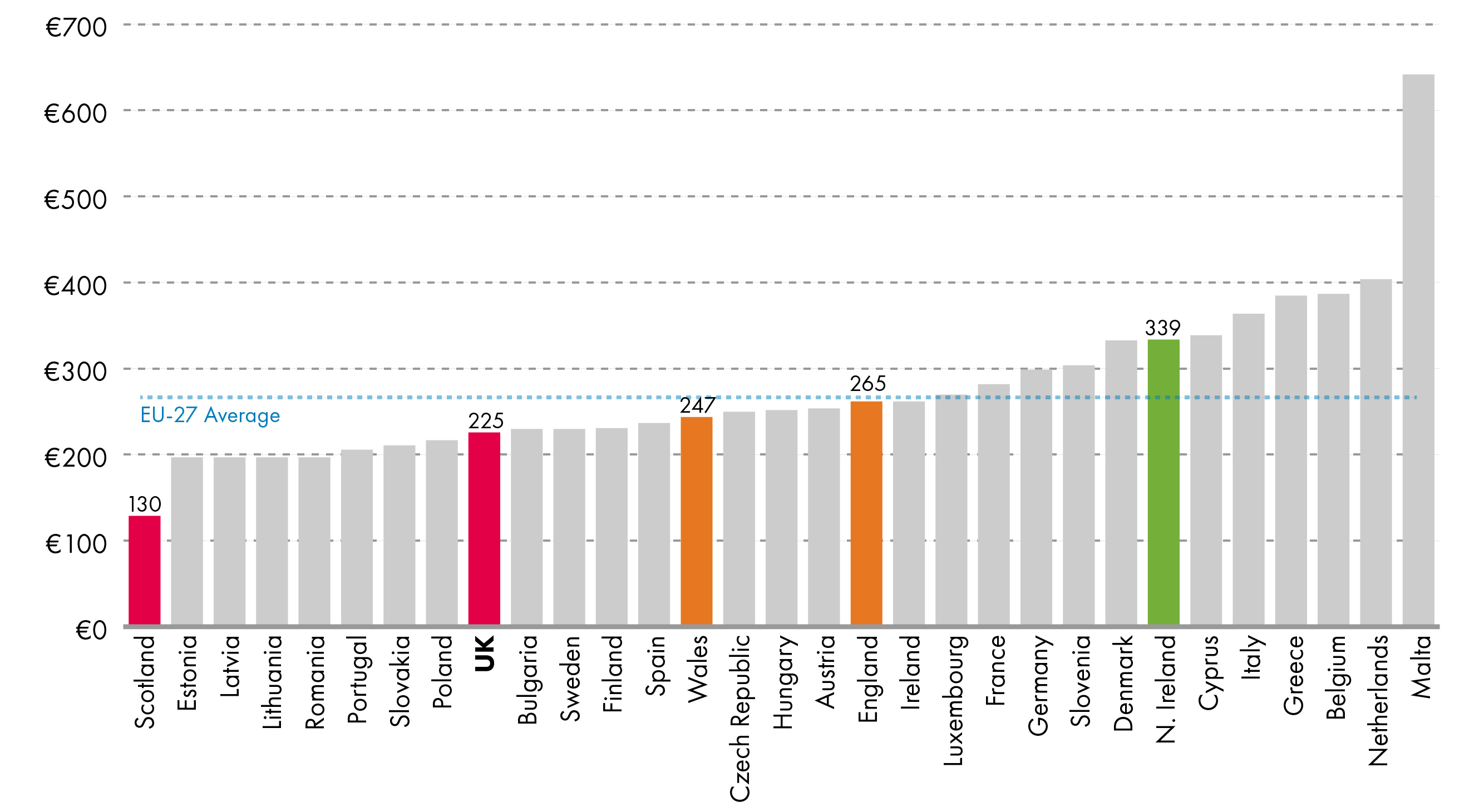
The UK average is €225 per hectare. In 2020 -
Scotland will receive €128 per hectare
Wales will receive €243 per hectare
England will receive €261 per hectare
Northern Ireland will receive €333 per hectare
Scotland's payment rate is due to historical allocations and the decision made by the UK Government in 2013 when allocating the CAP budget between the UK countries. Farmers are concerned that the current funding allocation may affect future allocations.
Scotland's allocation of Pillar 1 CAP funds, by farm
Scotland has one of the highest rates of direct farm funding, per farm, in the EU.
The UK government argued that Scotland did very well out of CAP funding when compared using a per farm measure. In a UK Government press release (8 November 2013) the then Scottish Secretary Alistair Carmichael, welcomed UK-won gains for Scottish farmers1 -
Scottish farmers will therefore retain the highest per farmer payment in the United Kingdom.
In 2012 Scotland received the highest payment per claimant (that is per farm) of direct subsidies of all of the UK countries. As Allen et al (2014) report -
Scotland received €35,020 per claimant
England received €25,162 per claimant
Wales received €21,544 per claimant
Northern Ireland received €9,390 per claimant2.
Others argued that figures showing Scottish farmers are the poor relations in Europe were not credible. In his blog, Matthews (2013) quotes George Lyon (then) MEP 3-
"Scottish farmers received an average Single Farm Payment of £25,751 per head, which is the second highest in the European Union and five times higher than the EU average of five thousand euros per farmer.
Scotland also has the highest payments per farmer in the UK, some eight thousand pounds per head higher than English farmers, who are in second place in the UK league table. Scottish farmers enjoy these high payments as a result of all their hard work building up the size of their farms in the past, as their payments are based on what they produced in 1999/2000/2001, not on some arbitrary Government decision."
More recently, Matthews (2019) has argued that "where the justification [for direct payments] is income support, the fact that the distribution of payments reflects the distribution of land ownership is irrelevant." A per farm rather than a per hectare comparison may be more informative4.
Who gets Pillar 1 funding in Scotland?
In relation to the convergence issue, Fergus Ewing, Cabinet Secretary for the Rural Economy, has said -
Scottish hill farmers are owed £160 million, which the UK Government has repeatedly ignored1.
However, the majority of Pillar 1 funding in Scotland does not go to hill farmers, but to farmers with better quality agricultural land, used for arable cropping, temporary grass and permanent grass.
The additional convergence funding received by the UK government is under Pillar 1. Pillar 1 payments consist of -
Basic payments = £262 million in 2019/20
Greening payments = £131.5 million in 2019/20
Other payments = £44.5 in 2019/202.
These "other payments" are Scottish Suckler Beef Support Scheme and the Scottish Upland Sheep Scheme. They make up 10% of all Pillar 1 payments in Scotland.
Taken together basic and greening payments make up 90% of Pillar 1 payments. Basic payments and greening payments are paid out in different amounts per hectare, according to three geographical regions in Scotland. As the Scottish Government rural payments website states3 -
The way we allocate funding means that Direct Payments (Basic Payment Scheme and Greening) will be paid on an area basis to reflect the variation in land quality across Scotland.
Region 1 includes better quality agricultural land, used for arable cropping, temporary grass and permanent grass. Payment is around €249 per hectare in 2019.
Region 2 includes rough grazing with a Less Favoured Areas (LFA) grazing category of B, C, D or non-LFA. Payment is around €50 per hectare in 2019.
Region 3 includes rough grazing with an LFA grazing category A. Payment is around €15 per hectare in 20193.
This means that different geographical regions receive different amounts of Pillar 1 funding. Scotland's Rural College (SRUC) have used the UK CAP payments website to show total payments for 2017 by postcode district for Pillar 15. Darker, browner colours show higher levels of funding.
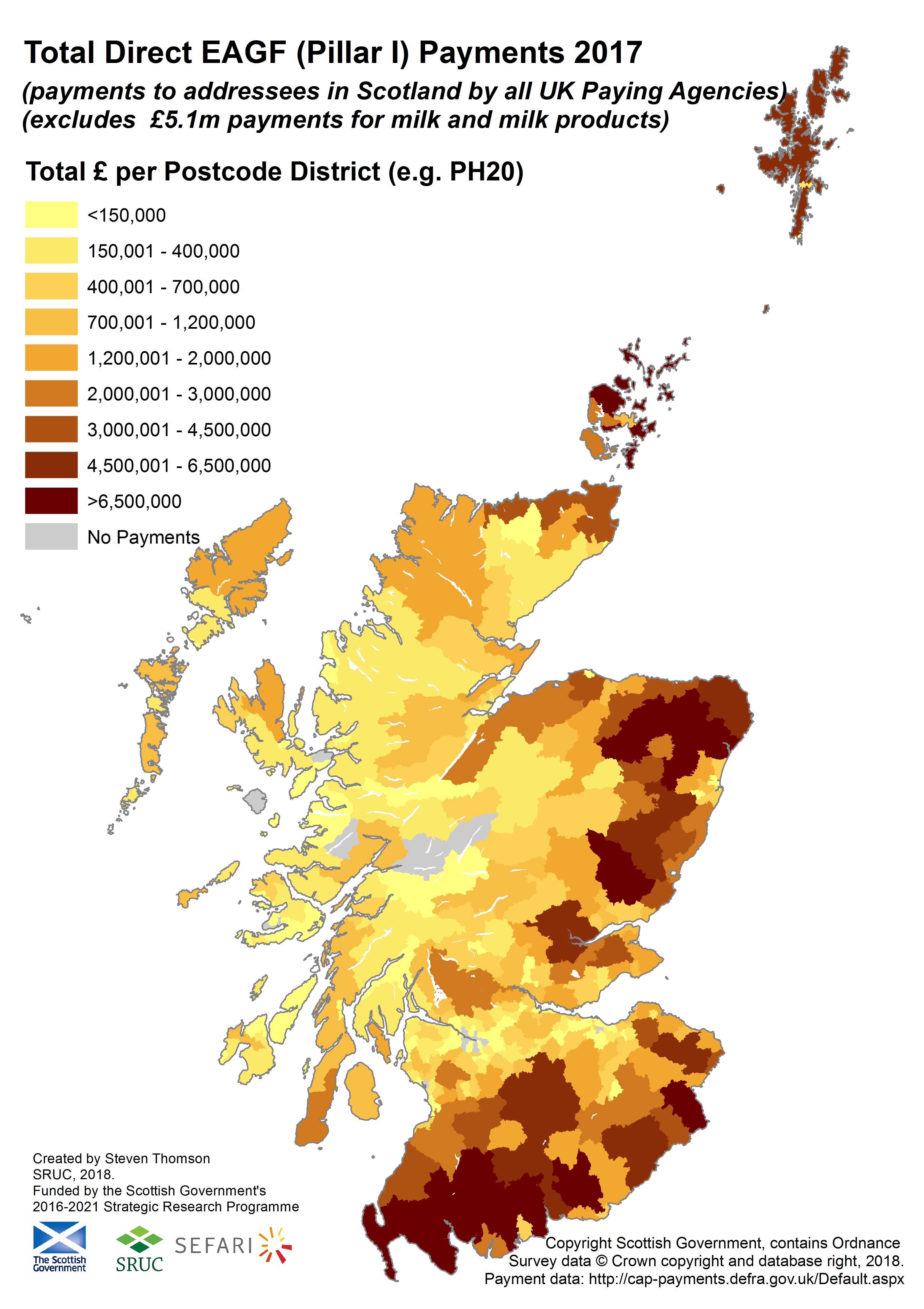
Review into UK allocation of farm support
The allocation of CAP funding in the UK has remained controversial since 2013. In the Scottish Parliament, there has been cross-party support for the full convergence uplift being allocated in its entirety to Scotland. On 24 April 2019, Peter Chapman said "As far as convergence money is concerned, you have our support. We have always given you support on that..."
As promised, though much delayed, the UK Government initiated an independent review into the convergence funding in December 2018. The review is looking at factors that should be considered to make sure that funding for domestic farm support is fairly allocated to the administrations of England, Scotland, Wales and Northern Ireland1.
The timeline below, summarises key events that led to this review.
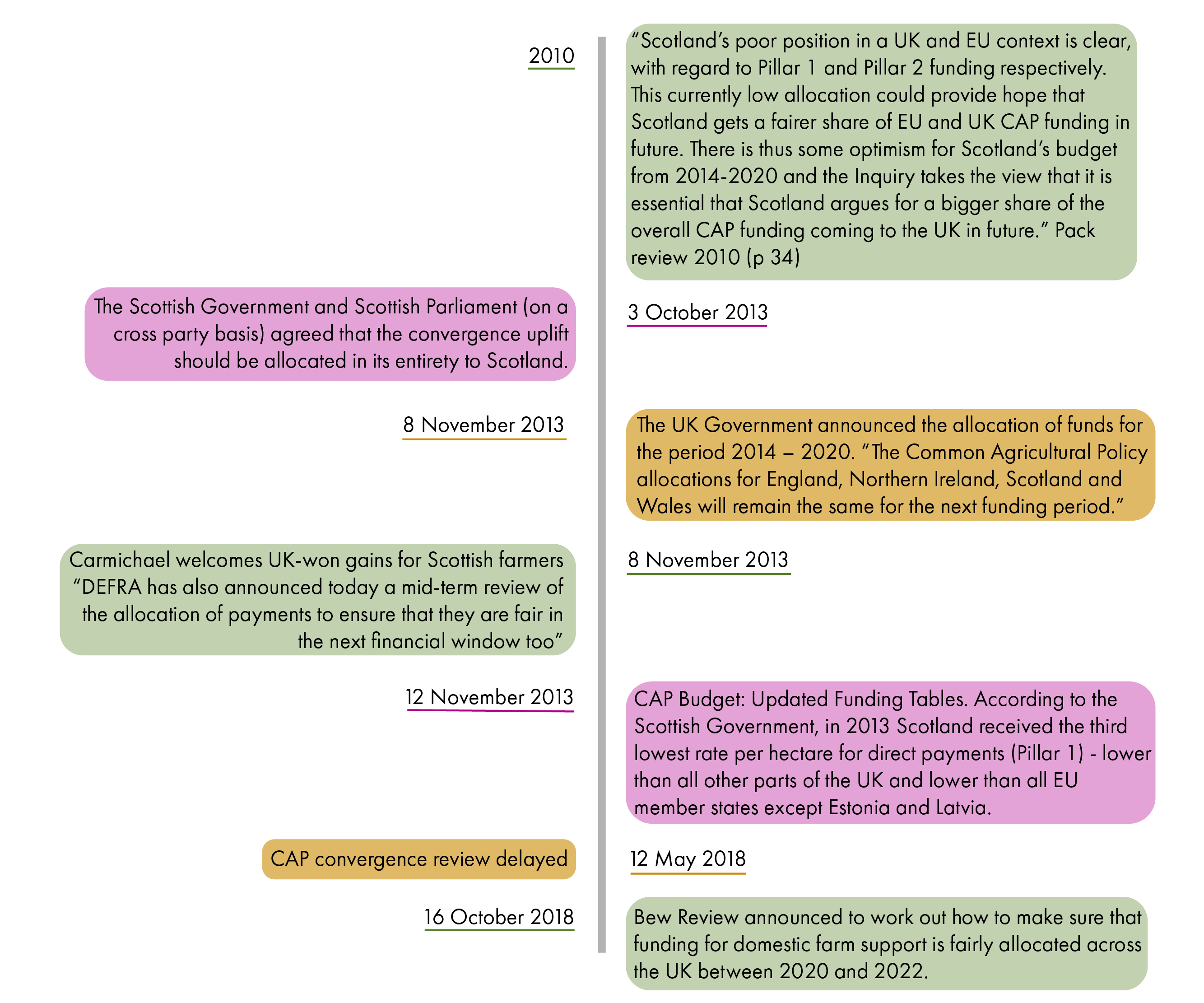
The Bew review
The review of the intra-UK allocation of domestic farm support is chaired by Lord Bew1. Scotland is represented on the advisory panel by Jim Walker (ex Chair of National Farmers Union Scotland, and Quality Meat Scotland).
The objective is to "look at what factors should be taken into account to ensure an equitable intra-UK allocation of domestic farm support funding to the end of this parliament. The review’s conclusions will be advisory."
The scope of the review is to -
inform domestic intra-UK agricultural funding allocations under the farm support manifesto commitment to the end of this parliament, limited to the quantum of convergence funding.
consider a wide range of factors reflecting the environmental, agricultural and socio-economic circumstances of each of the four parts of the UK.
be fiscally neutral within the envelope set by the farm support manifesto commitment.
The review will not:
revisit the intra-UK allocation of 2014-2020 Common Agricultural Policy (CAP) funding
set the quantum of funding under the farm support manifesto commitment
pre-empt decisions to be made on the agricultural funding arrangements beyond 2022.
Written submissions have been invited from stakeholders, and Lord Bew has met interested parties including the Scottish Government, the National Farmers Union for Scotland, Scottish Land and estates and Scottish Environment LINK.
The final report of the review will be published in the summer of 2019.
Issues related to the review
Whilst the report of the review has not yet been published, some issues have already been identified -
Terms of Reference
Michael Gove MP, Secretary of State for Environment, Food and Rural Affairstold the Scottish Parliament Rural Economy and Connectivity Committee on 15 May 2019 that "terms of reference have been agreed". However, it has been reported that the Scottish Government said "there were still some 'unresolved matters' with the review Terms of Reference proposed by the UK Government ... they were published without consultation with the Devolved Administrations and 'watered down' on the previously agreed remit."
The Scottish Government submission (pers comm) to the review stated that -
"The review will therefore fail in terms of repatriating the monies withheld from Scottish farmers and crofters over the last six years. This unhelpfully places the representatives from the home nations of the UK in a four way tug of war over the convergence pot for the coming years, something we all agreed we were keen to avoid.
In terms of scope, the revised Terms of Reference also refer to considering a wide range of factors that reflect the environmental, agricultural and socio-economic circumstances of England, Scotland, Wales and Northern Ireland, and is therefore imperative that the panel keeps in focus the principle of convergence in area based payments."
Advice given to a previous Secretary of State
More recently, there have been reports (Scotsman, 17 May 2019) that the UK Government has not sent some documents to the review. The Scotsman reported that "some key information relating to advice given to a previous secretary of state, Owen Paterson, is being held up - believed to be blamed on the 30-year public disclosure of government papers."